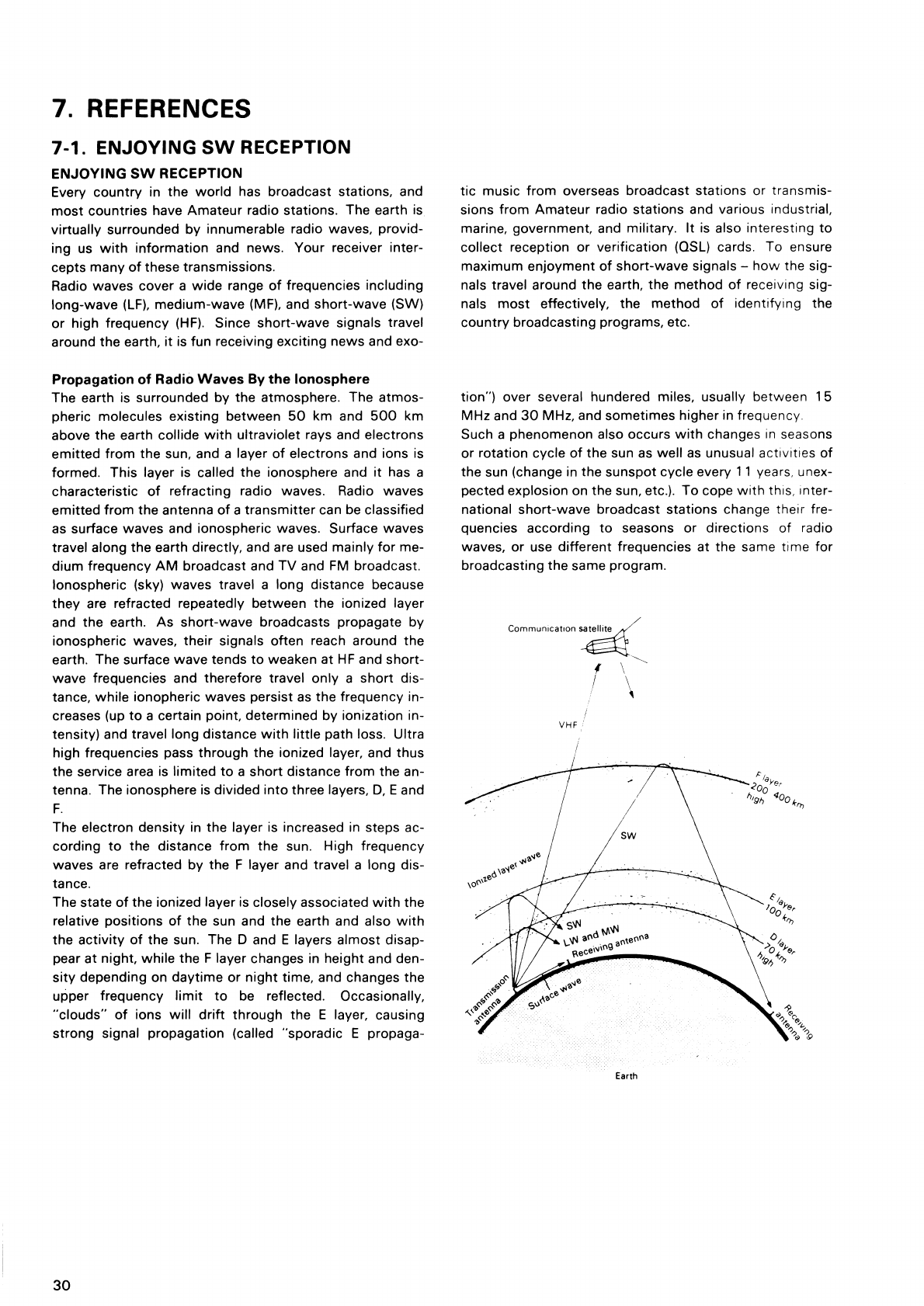
tic music from overseas broadcast stations or transmis-
sions from Amateur radio stations and various industrial,
marine, government, and military. It is also interesting to
collect reception or verification (QSL) cards. To ensure
maximum enjoyment of short-wave signals - how the sig-
nals travel around the earth, the method of receiving sig-
nals most effectively, the method of identifying the
country broadcasting programs, etc.
tion") over several hundered miles, usually between 15
MHz and 30 MHz, and sometimes higher in frequency.
Such a phenomenon also occurs with changes in seasons
or rotation cycle of the sun as well as unusual activities of
the sun (change in the sunspot cycle every 11 years, unex-
pected explosion on the sun, etc.). To cope with this, inter-
national short-wave broadcast stations change their fre-
quencies according to seasons or directions of radio
waves, or use different frequencies at the same time for
broadcasting the same program.
7. REFERENCES
7-1. ENJOYING SW RECEPTION
ENJOYING SW RECEPTION
Every country in the world has broadcast stations, and
most countries have Amateur radio stations. The earth is
virtually surrounded by innumerable radio waves, provid-
ing us with information and news. Your receiver inter-
cepts many of these transmissions.
Radio waves cover a wide range of frequencies including
long-wave (LF), medium-wave (MF), and short-wave (SW)
or high frequency (HF). Since short-wave signals travel
around the earth, it is fun receiving exciting news and exo-
Propagation of Radio Waves By the Ionosphere
The earth is surrounded by the atmosphere. The atmos-
pheric molecules existing between 50 km and 500 km
above the earth collide with ultraviolet rays and electrons
emitted from the sun, and a layer of electrons and ions is
formed. This layer is called the ionosphere and it has a
characteristic of refracting radio waves. Radio waves
emitted from the antenna of a transmitter can be classified
as surface waves and ionospheric waves. Surface waves
travel along the earth directly, and are used mainly for me-
dium frequency AM broadcast and TV and FM broadcast.
Ionospheric (sky) waves travel a long distance because
they are refracted repeatedly between the ionized layer
and the earth. As short-wave broadcasts propagate by
ionospheric waves, their signals often reach around the
earth. The surface wave tends to weaken at HF and short-
wave frequencies and therefore travel only a short dis-
tance, while ionopheric waves persist as the frequency in-
creases (up to a certain point, determined by ionization in-
tensity) and travel long distance with little path loss. Ultra
high frequencies pass through the ionized layer, and thus
the service area is limited to a short distance from the an-
tenna. The ionosphere is divided into three layers, D, E and
F.
The electron density in the layer is increased in steps ac-
cording to the distance from the sun. High frequency
waves are refracted by the F layer and travel a long dis-
tance.
The state of the ionized layer is closely associated with the
relative positions of the sun and the earth and also with
the activity of the sun. The D and E layers almost disap-
pear at night, while the F layer changes in height and den-
sity depending on daytime or night time, and changes the
upper frequency limit to be reflected. Occasionally,
"clouds" of ions will drift through the E layer, causing
strong signal propagation (called "sporadic E propaga-
30


















